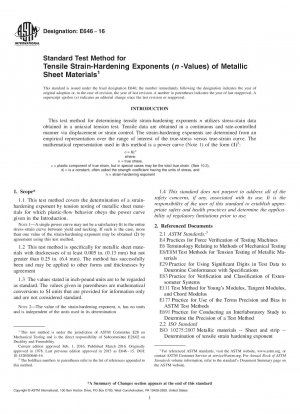ASTM E646-16
Standard Test Method for Tensile Strain-Hardening Exponents (n -Values) of Metallic Sheet Materials
- Standard No.
- ASTM E646-16
- Release Date
- 2016
- Published By
- American Society for Testing and Materials (ASTM)
- Latest
- ASTM E646-16
- Scope
5.1 This test method is useful for estimating the strain at the onset of necking in a uniaxial tension test (1). Practically, it provides an empirical parameter for appraising the relative stretch formability of similar metallic systems. The strain-hardening exponent is also a measure of the increase in strength of a material due to plastic deformation.
5.2 The strain-hardening exponent may be determined over the entire plastic stress-strain curve or any portion(s) of the stress-strain curve specified in a product specification.
Note 4: The engineering strain interval 10–20% is commonly used for determining the strain-hardening exponent, n, of formable low-carbon steel products
5.3 This test method is not intended to apply to any portion of the true stress versus true strain curve that exhibits discontinuous behavior; however, the method may be applied by curve-smoothing techniques as agreed upon.
Note 5: For example, those portions of the stress-strain curves for mild steel, aluminum, or other alloys that exhibit yield point and Lüders band elongation, twinning, or Portevin–Le Chatelier effect (PLC) may be characterized as behaving discontinuously.
Note 6: Caution should be observed in the use of curve-smoothing techniques as they may affect the n-value.
5.4 This test method is suitable for determining the tensile stress-strain response of metallic sheet materials in the plastic region prior to the onset of necking.
5.5 The n-value may vary with the displacement rate or strain rate used, depending on the metal and test temperature.
1.1 This test method covers the determination of a strain-hardening exponent by tension testing of metallic sheet materials for which plastic-flow behavior obeys the power curve given in the Introduction.
Note 1: A single power curve may not be a satisfactory fit to the entire stress-strain curve between yield and necking. If such is the case, more than one value of the strain-hardening exponent may be obtained (2) by agreement using this test method.
1.2 This test method is specifically for metallic sheet materials with thicknesses of at least 0.005 in. (0.13 mm) but not greater than 0......
ASTM E646-16 Referenced Document
- ASTM E111 Standard Test Method for Young''s Modulus, Tangent Modulus, and Chord Modulus
- ASTM E177 Standard Practice for Use of the Terms Precision and Bias in ASTM Test Methods
- ASTM E29 Standard Practice for Using Significant Digits in Test Data to Determine Conformance with Specifications
- ASTM E4 Standard Practices for Force Verification of Testing Machines
- ASTM E6 Standard Terminology Relating to Methods of Mechanical Testing
- ASTM E691 Standard Practice for Conducting an Interlaboratory Study to Determine the Precision of a Test Method
- ASTM E8/E8M Standard Test Methods for Tension Testing of Metallic Materials
- ASTM E83 Standard Practice for Verification and Classification of Extensometer
ASTM E646-16 history
- 2016 ASTM E646-16 Standard Test Method for Tensile Strain-Hardening Exponents (
n -Values) of Metallic Sheet Materials - 2015 ASTM E646-15 Standard Test Method for Tensile Strain-Hardening Exponents (
n -Values) of Metallic Sheet Materials - 2007 ASTM E646-07e1 Standard Test Method for Tensile Strain-Hardening Exponents 40;
n -Values41; of Metallic Sheet Materials - 2007 ASTM E646-07 Standard Test Method for Tensile Strain-Hardening Exponents (n -Values) of Metallic Sheet Materials
- 2000 ASTM E646-00 Standard Test Method for Tensile Strain-Hardening Exponents (n-Values) of Metallic Sheet Materials

Copyright ©2024 All Rights Reserved